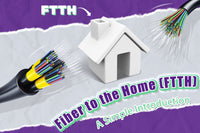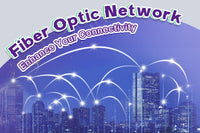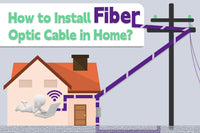Contents
What’s the solution to the ever-growing demands for high-speed network speed with the surging of VR, AI, and real-time conferences? Fiber internet is a great alternative to the traditional internet. Compared with traditional copper cables, fiber optic cables enable a high-speed and secure signal transmission. Fiber to the “x” (FTTx) is a generic term for different types of broadband optical networks, including FTTH, FTTB, FTTC, and so on. Continue reading to explore more about FTTH and FTTx.
What is FTTx?
FTTx refers to “Fiber to the x” which is a broad term for various types of optical broadband architecture. “x” in “FTTx” symbolizes different fiber endpoints or locations like homes, buildings, curbs, etc. FTTx is designed to deliver high-speed data transmission or telecommunications to a specific point. Common configurations include Fiber to the Home (FTTH), Fiber to the Building (FTTB), Fiber to the Curb (FTTC), and Fiber to the Node (FTTN) based on different fiber deployments. As a crucial technology in fiber optic communication, FTTx is indispensable for reliable broadband connectivity.
Types of FTTx
FTTx is a concept containing various types of broadband architecture. Here we list some common types.
FTTP
It stands for “Fiber to the Premise”, which means that the fiber internet line can reach the users’ premises. FTTP is a relatively larger term and covers Fiber to the Home (FTTH) and Fiber to the Building (FTTB).
- FTTH
As its name suggests, FTTH is a technology that uses fiber optic cables to reach the boundary of a household. For example, a network box is often installed on the wall outside of a house in an FTTH network.
In FTTH deployment, the fiber optic cables start from the ISP’s central office to the user’s premises over the optical distribution network (ODN). FTTH generally uses the PON system to deliver broadband network access. The FTTH technology uses hair-thin fibers in the last mile of the cabling (“mile” is just a metaphor, not the real distance).
FTTH has gradually become the standard for ISPs as it can provide excellent network experience for customers with large data processing (including data, voice, and video.)
- FTTB
FTTB refers to fiber to the building, basement, or business. Unlike FTTH, it doesn’t directly reach the individual household but to the multi-story building or apartment. The termination box is usually located in the basement of the building. Once the signal is transmitted to the office building or apartment via optical fiber, it is then transmitted via coaxial cables or twisted cables within the building or apartment. FTTB is often deployed in urban areas.
FTTN
FTTN is short for fiber to the node, which is also known as fiber to the neighborhood. Fiber optic cabling is deployed in the street or neighborhood node in FTTH, providing a broadband connection through a common network box (a large-scale optical receiver). The distance between the network box and the premise will impact the performance of the FTTN network. It should be noted that copper or coaxial cables are used in the last part connection of FTTN.
FTTC
FTTC is usually explained as fiber to the cabinet or fiber to the curb. The fiber line is terminated in a cabinet no more than 300 meters from the user’s home. The curb or cabinet is located closer to households or businesses than to the central office. Compared with FTTN, FTTC has a fiber termination box closer to the user’s home. The final connection to the individual premise is achieved by copper or coaxial cables.
There are also other fiber network architectures like FTTA and FTTF. Fiber to the antenna (FTTA), also known as fiber to the air, is a wireless technology that connects antennas or remote radio units (RRU) to the fiber optic network by fiber optic cable rather than copper wires. FTTF refers to fiber to the floor, frontage, farm and factory. Fiber to the floor and fiber to the frontage are similar to FTTB. Fiber to the farm and factory provides fiber optic technology to the industry and agriculture that largely improves the efficiency.

Is FTTH Better Than FTTN/FTTC?
FTTH provides a better performance than FTTN/FTTC because FTTH directly connects the fiber optic cables to the individual or business. FTTN and FTTC use copper or coaxial cables for the last segment of the connection, which may restrict the bandwidth and network speed of the whole transmission. FTTH offers a high-speed transmission speed and symmetrical bandwidth for better internet performance.
How Does FTTH and FTTx work?
So, how does FTTx work? Here, we take FTTH as an example.
FTTH works by sending the light signal from the ISP to the user’s home by fiber optic cables. Fiber optic cables are also used in the last mile instead of copper or coaxial cables in the FTTH network.
A passive optical network (PON) is the typical working mode of FTTH. PON technology consists of mainly three components: optical line terminal (OLT), optical network terminal (ONT), and optical distribution network (ODN).
- OLT servesas the multi-service and network management platform. It helps receive data from the network and then send it to ODN.
- ODN is used to split and distribute the optical signal from the ISP network to ONT or ONU located at the premises’
- ONT is usually located at the user’s home, designed to convert the light signal to an electrical signal and then to the subscribers.
Benefits of FTTx
FTTx offers numerous benefits, making it a good network choice in modern life. Fiber optic cable provides a higher speed than traditional copper cables, enabling improved network performance. Fiber optic cables transmit a light signal instead of an electrical signal, making them resistant to electromagnetic interference. This ensures a secure and reliable connection for users. FTTx technology is a crucial component of modern telecommunication and will remain indispensable in the future.
Future of FTTx
The growing demands for improved internet infrastructure across various sections - ranging from education and entertainment to the economy and medical applications - have boosted the development of the network. The FTTx technology is definitely the future-proofing choice for both individual users and businesses.
It is known that FTTx technology is immune to external interference and crosstalk, providing high-speed and secure data transmission over long distances. As industries and businesses increasingly rely on cloud computing, IoT, and enhanced remote work, investing in FTTx is crucial for establishing a consistent and reliable network in the future.
FAQs
Is FTTH better than DSL?
Yes. Fiber of FTTH transmits signal faster than copper phone lines of DSL.
What are the benefits of FTTx over traditional copper networks?
FTTx provides higher bandwidth, higher speeds, and lower latency, and is safer than traditional copper networks.
Does FTTx guarantee a fiber connection?
No, though FTTx uses fiber optic cable to connect different terminations to the fiber optic network, some configurations, such as FTTN and FTTC, still rely on copper cables in the last mile.
For more information on this topic, you can keep up on our blogs. While VCELINK offers general and basic information for our customers and other visitors to the website, it’s not professional advice.




Be the first one to comment.
Leave a comment